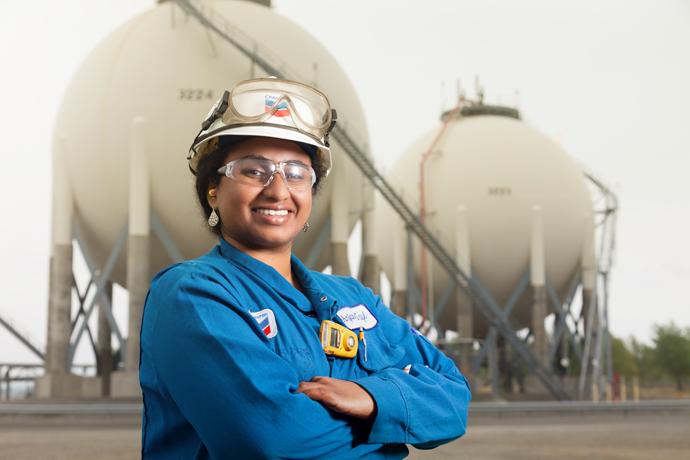
CHEVRON: MARKETS ARE BETTER

Crude oil markets are coming back into "better balance" as supplies are cut back in response to lower prices, Chevron Chief Executive Officer and Chairman John Watson said Tuesday.
The oil industry in early 2015 responded to lower revenue by reducing spending on long-cycle projects, Watson told journalists on the sidelines of the LNG 18 conference in Perth, Western Australia.
"Now we're seeing reductions in spending on shorter cycle projects, in other words immediate drilling activity," Watson said. "Rig rates in the US are down almost 80%, we're seeing decline in rig rates around the world and we're starting to see the supply response that everyone has expected. So we're seeing the markets come back into better balance [but] it may take more time."
Watson declined to make any forecasts, but the oil prices seen over the last year would "not underpin very much activity," he stressed.
"So I expect that we'll see a price response," Watson added. "Some of that is evident in the market but that can be uneven."
For Chevron, the reduction in revenue from its upstream business had meant the company had to live within its means, Watson said.
"It means we're finishing the projects that are under construction ... and we are bringing our costs down so we can meet the commitments we have to our shareholders by paying dividends while continuing to reinvest in the business," he added. "We are reinvesting in short-cycle developments that have good returns even in a low price world and we're making some choices on the longer cycle projects that we initiate."
Although global crude oil production is projected to continue to increase over the medium term, there is some uncertainty over the full effect of the industry's recent cuts to exploration and development expenditure, according to the latest quarterly report from the Office of the Chief Economist in the Australian government's Department of Industry, Innovation and Science. Oil companies reduced capital spending on exploration and development by 24% in 2015, equivalent to the deferral of around 20 billion barrels of reserves, with similar cuts expected in 2016.
"Estimates from the International Energy Agency suggest that 85% of the investment required to meet demand for oil and gas over the longer-term is simply devoted to offsetting natural decline at existing fields," the Office of the Chief Economist said. "If recent cuts to capital expenditure fail to account for this, producers may struggle to merely maintain current levels of production, leading to a supply deficit."
Global oil production grew by 2.8% in 2015 to an average of 96.4 million b/d, up 2.6 million b/d year on year, and marking the largest increase since 2004, according to the report. The increase in world production in 2015 was largely the result of continued but slower production growth in the US in the first half of the year, and a strong increase in OPEC supply.
Global oil production is expected to remain relatively flat in 2016, with slower growth in OPEC supply just outweighing a decline in non-OPEC supply, the Office of the Chief Economist said. From 2017 onwards, the world's production is projected to increase by 0.8% annually, reaching 100.5 million b/d in 2021.
GORGON LNG PROJECT PRODUCING AT UNDER $30/B
Meanwhile, Watson said Chevron's new Gorgon LNG project on Barrow Island off Western Australia would produce at a cost of under $30/b. "So Gorgon will be profitable at any kind of reasonable prices," he added.
Gorgon's train one, which has a capacity of 5.2 million mt/year, began producing LNG on March 7, but was shut down earlier this month due to a mechanical issue in the propane refrigerant circuit. The project's first LNG cargo departed Barrow Island on March 21 and was delivered to Chubu Electric Power in Japan on April 6.
Chevron said last week that repair work was ongoing and a restart of train one was expected "within 30-60 days." Trains two and three at the project are expected to start up at six monthly intervals.
The shutdown has been viewed as a significant setback for Gorgon, which is Australia's largest-ever resource development and cost a total of $54 billion. Gorgon was approved in 2009 when it was expected to cost $37 billion and start up in 2014, but the project suffered major blow-outs due to construction and weather delays.
Chevron's interest in Gorgon is 47.3%. Its partners in the project are ExxonMobil and Shell with 25% stake each, and Japanese customers Osaka Gas (1.25%), Tokyo Gas (1%) and Chubu Electric Power (0.417%).
The US company is also the operator of the $29 billion Wheatstone LNG project, which is being constructed at a site near Ashburton on the Western Australian mainland. The two-train, 8.9 million mt/year Wheatstone project was originally expected to begin production before the end of 2016, but startup has now slipped to mid-2017.
Chevron owns 64.14% of Wheatstone, with Kuwait Foreign Petroleum Exploration Co. holding 13.4%, Woodside Petroleum 13%, Kyushu Electric Power Co. 1.46% and PE Wheatstone, which is part-owned by Japan's Tepco, the remaining 8%.
Chevron produced 2.62 million b/d of oil equivalent in 2015, up 2% from 2014's 2.57 million boe/d. For 2016, the company has forecast an increase of between zero and 4%, which translates into a variance of up to 105,000 boe/d.
Each LNG production train at Gorgon and Wheatstone will account for around 70,000 boe/d of Chevron's output.
-----
More:
2016: OIL & GAS INVESTMENTS DOWN TO $522 BLN




